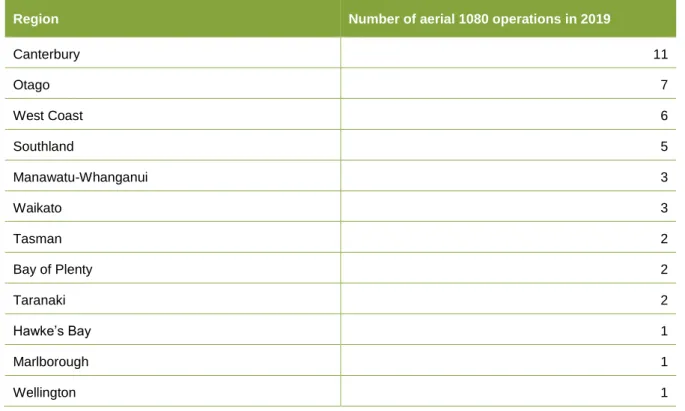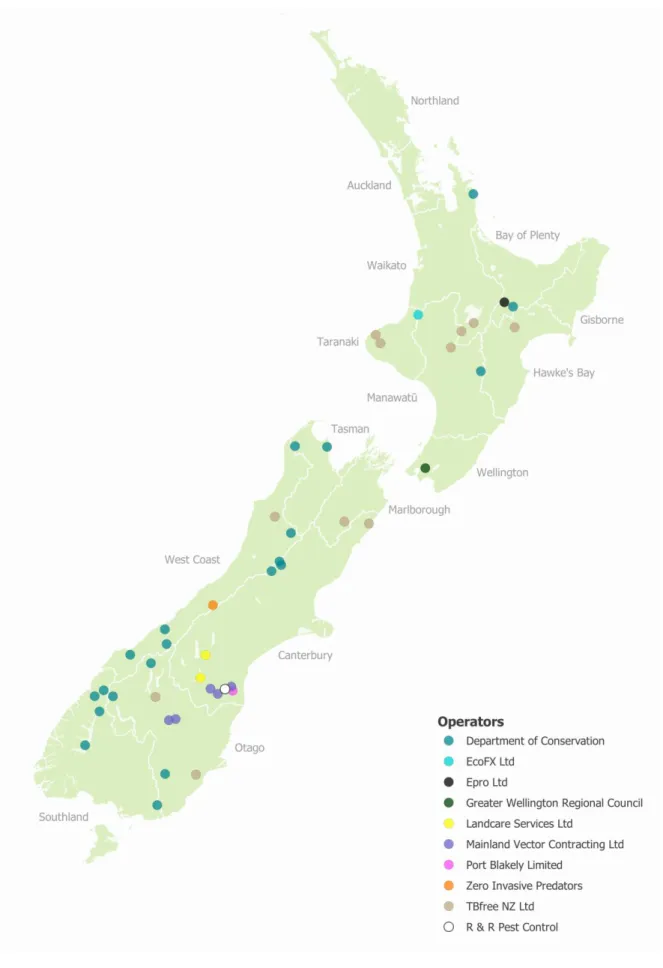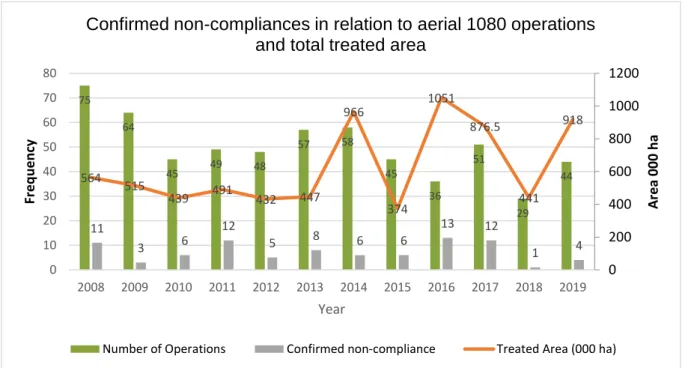This 13th annual report on the use of 1080 in Aotearoa New Zealand aims to make the use and regulation of 1080 as transparent as possible. It is heavily regulated under the Hazardous Substances and New Organisms Act (HSNO) 1996, which sets out the rules for the use of 1080. Four studies were published in scientific journals during 2019 on the results of 1080 operations on bird and pest species.
In 2007, the Environmental Risk Management Authority (EPA's predecessor) reassessed the use of 1080 in New Zealand and consulted the public extensively. The timing of 1080 operations is dictated and adjusted according to information about the population and dynamics of target pests.

Operators that applied 1080 aerially in 2019
Port Blakely funded a 1080 aerial operation in the Waimate Forest to reduce the impact of wallabies on the exotic tree planting program. ZIP was founded as a pioneer in predator control using a 'remove and protect' strategy to completely eliminate rats, stoats and possums from large areas of the mainland and permanently protect those areas from re-invasion. R&R Pest control is a privately owned pest control company based in the Waitaki Valley and has been operating since 2009.
Reporting after aerial 1080 operations
Rules for 1080 formulations and application rates
These rates were significantly lower than the maximum approved rate of 30 g of 1080 per hectare set by the 2007 reassessment conditions. In 2019, the average bait application rate for possum and rodent control operations was 2.1 kg bait per hectare. In 2019, the average bait application rate for rabbit control operations was 15.8 kg of root bait per hectare.
Thirty-nine of the 44 operations used grain bait pellets containing between 1.5 and 2.0 g of 1080 per kg bait. The other five operations used carrot baits containing between 0.2 and 0.8 g of 1080 per kg of bait to target rabbits.
Location of operations
Data from operations over a number of years show that operators typically use much less than this amount. All bait formulation and application rates used in 2019 operations complied with the existing HSNO controls. The reason for the larger treated areas in some regions is partly the differences in the natural environment.
For example, the West Coast has 37 percent native forest cover, large areas of which are inaccessible by vehicle. Aerial application of 1080 on the West Coast is considered a key tool for possum and rodent control.

Size of operations
Protecting public health
Agencies with delegated power for 1080 permissions
Management of water intakes to protect public health
Monitoring provides assurance that water supplies are safe
The results of the water samples tested after 1080 air operations in 2019 were below the maximum acceptable value for drinking water and therefore did not pose a risk to water supplies. This is consistent with previous research on the unlikelihood of 1080 (when applied in accordance with the controls) to contaminate water supplies.8. We expect that water sampling and testing across treated and affected areas will continue to provide assurance to regulators and communities that 1080 remains within acceptable limits based on the Ministry of Health's provisional maximum acceptable value for 1080 in drinking water.
Communication
Consultation with Māori
Consultation with hunting groups
Changes to operations after consultation
For 19 operations, the operators modified the proposed boundaries for the application area in response to feedback. The timing was changed for two operations due to livestock movement and planned hunting activities. One operation changed from aerial application to ground application of 1080 for parts of the treatment area.
This shows that early involvement with Māori and other affected groups during the planning phase benefits both operators and stakeholders.
Assessing applications against the communications guidelines
Outcomes of 1080 aerial operations
Benefits for TB eradication
Benefits for native species
A long-term approach
Pest numbers before and after operations
Overall assessment of the operations
1080 research in 2019
Research in 2019
Started in 2016, this project aims to design and manufacture a 1080 air lure suitable for stoat. The flow rate, distribution pattern, and calibration of buckets used in Aerial 1080 operations are also analyzed to determine whether gaps in bait distribution affect predator kill rates. Effectiveness of alpine pest control: evaluation of aerial 1080 applied to and above the tree line adjacent to a range of forest species.
In conjunction with this project, a related, ongoing project entitled: "Does productivity and survival of whio change over a breeding season before and after aerial 1080 predator control?" is underway. Researchers could not get clear results in 2019 on Roaring Lion due to low growth and an irregular 1080 aerial operation in Kahurangi National Park. This project is also linked to the Save Our Iconic Kiwi (SOIK) research, which is examining the benefits of aerial 1080 for roroa in non-mast years.
A case study of the drylands of the Eyre Mountains. This ongoing research will investigate the effects of aerial 1080 on native lizards. Aerial 1080 has been shown to be an effective control of introduced mammalian predators that prey on lizards, but mouse populations sometimes increase following Aerial 1080 operations. With lizards preying on mice, this research aims to investigate the effect that a common 1080 antenna has on lizards in the dry ecosystem of the Eyre Mountains.
Lizard populations will be surveyed during several 1080 aerial operations in treated and untreated areas over a three-year time period (expected completion June 2023). This project aimed to determine whether aerial 1080 can increase the population of endangered people in the South Island, without the additional support of ground control. The project collected long-term population trends in Kahurangi National Park during periods with and without continuous mast-driven aerial 1080 operations to understand trends at sites.
This new project will address the current lack of data regarding non-target impacts on Kea from 1080 aerial operations for the first time in remote areas. This research, launched in 2017, aims to develop new approaches to eliminating TB without using air 1080 in remote areas.
Manufacturers who undertook research projects in 2019
In late 2019, OSPRI researchers reviewed previous research on ways to improve 1080 as a toxin to make it more human. Researchers at Manaaki Whenua - Landcare Research have identified key attractive compounds in the scent that female possums give off during heat, and have confirmed that these cause a significant increase in possum capture rates when tested in the field. Orillion works closely with Manaaki Whenua – Landcare Research and industry partners Department of Conservation, OSPRI and MPI to improve knowledge, safety and cost-effectiveness of bait production, use and storage.
The paper advocates managing risks to kea posed by air 1080 use in the South Island by focusing on reducing human food availability through a public campaign. In the blocks that were not pre-fed, rat numbers decreased less, and the survivors were bait-averse. No evidence of negative effects of aerial 1080 operations on red deer (Cervus elaphus) encounters and sightings in South Westland forests.
To address concerns that aerial 1080 operations could negatively impact deer hunting in New Zealand's forests, researchers from the Department of Conservation and Manaaki Whenua - Landcare Research recorded the number of encounters and numbers of deer. The models, developed between 2011 and 2015 based on 865 days of surveys by experienced wildlife field technicians, showed that there was no evidence that 1080 aerial operations reduced the number of red deer encounters or the number of individual deer seen over long periods of time. time period, in neither treated nor untreated -treated blocks. Models fitted to data from 1080-treated blocks showed only a trend such that deer encounters and individual deer sightings were highest immediately after aerial 1080 surgery and declined over the next 2-3 years.
The authors concluded that further research in this area would be warranted and recommend involving mātāturangā Māori in the search for more targeted toxins and delivery systems that may lead to more culturally acceptable pest control. The paper was published in the New Zealand Journal of Ecology in November 2019 as part of the special issue on Mātaurangā Māori (Ogilvie, S.C. et al., 2019). Researchers at the Department of Conservation investigated the impact of aerially applied poison 1080 on a population of western wekas in the Marlborough Sounds.
Researchers noted that most weka in the treated block were sub-lethally poisoned, but only one of the 58 radio-tagged weka died as a direct result of the air 1080 operations. Adults and chicks in the treated block experienced higher survival rates, but nest success was unaffected despite the declines in rat and vole abundances observed after the 1080 operation. The paper was published in the New Zealand Journal of Ecology in October 2019 (Tinnemans, J.S. et al., 2019).
Incidents and matters of public concern
Incident summaries
Department of Conservation and Taranaki Regional Council staff found eight decoys in the car park at the North Egmont Visitor Centre. The incident was investigated by the PHU and found the misuse to be a breach of the operator's licence. Due to a defective 1080 bulk bag, the contents of the bag were spilled on the ground within the loading zone.
Small pieces on the ground of the loading area were wetted and the ground was cleaned. A complaint was made to the Department of Conservation, Ministry of Health and EPA by a member of the public, including concerns about the timing of the operation, location and cleaning of the loading site. A farm manager on an adjacent farm had not been informed of the details of the operation by the landowner, and therefore claimed he had not been consulted.
A complaint was made that a water supplier and a water user had not been identified. The trampers had stayed in the hut the night of the operation and observed 1,080 pellets and dead rats around the hut. When the helicopter's GPS flight lines were run through the Department of Conservation's model, it showed a possible overlap of the exclusion zone around Young Hut in the Young Valley.
A single bait was found during routine clearing of the Lake Gunn Nature Walk course, which had been excluded from the operation. The investigation by the Public Health Unit concluded that the bait either fell through the canopy or was thrown from the funnel, and that the misapplication was a violation of the permission they issued for this operation. In addition to the overview below, an updated version of the postoperative report can be found on our website.
Investigation of tutin, a natural plant toxin, as a new, culturally acceptable rodenticide in New Zealand. Factors affecting survival and long-term population viability of New Zealand long-tailed bats (Chalinolobus tuberculatus): Implications for conservation. Landscape-scale applications of 1080 pesticide benefit North Island brown kiwi (Apteryx mantelli) and New Zealand fantail (Rhipidura fuliginosa) in Tongariro Forest, New Zealand.



